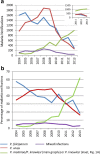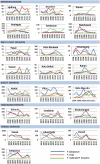Changing epidemiology of malaria in Sabah, Malaysia: increasing incidence of Plasmodium knowlesi
- PMID: 25272973
- PMCID: PMC4195888
- DOI: 10.1186/1475-2875-13-390
Changing epidemiology of malaria in Sabah, Malaysia: increasing incidence of Plasmodium knowlesi
Abstract
Background: While Malaysia has had great success in controlling Plasmodium falciparum and Plasmodium vivax, notifications of Plasmodium malariae and the microscopically near-identical Plasmodium knowlesi increased substantially over the past decade. However, whether this represents microscopic misdiagnosis or increased recognition of P. knowlesi has remained uncertain.
Methods: To describe the changing epidemiology of malaria in Sabah, in particular the increasing incidence of P. knowlesi, a retrospective descriptive study was undertaken involving a review of Department of Health malaria notification data from 2012-2013, extending a previous review of these data from 1992-2011. In addition, malaria PCR and microscopy data from the State Public Health Laboratory were reviewed to estimate the accuracy of the microscopy-based notification data.
Results: Notifications of P. malariae/P. knowlesi increased from 703 in 2011 to 815 in 2012 and 996 in 2013. Notifications of P. vivax and P. falciparum decreased from 605 and 628, respectively, in 2011, to 297 and 263 in 2013. In 2013, P. malariae/P. knowlesi accounted for 62% of all malaria notifications compared to 35% in 2011. Among 1,082 P. malariae/P. knowlesi blood slides referred for PCR testing during 2011-2013, there were 924 (85%) P. knowlesi mono-infections, 30 (2.8%) P. falciparum, 43 (4.0%) P. vivax, seven (0.6%) P. malariae, six (0.6%) mixed infections, 31 (2.9%) positive only for Plasmodium genus, and 41 (3.8%) Plasmodium-negative. Plasmodium knowlesi mono-infection accounted for 32/156 (21%) and 33/87 (38%) blood slides diagnosed by microscopy as P. falciparum and P. vivax, respectively. Twenty-six malaria deaths were reported during 2010-2013, including 12 with 'P. malariae/P. knowlesi' (all adults), 12 with P. falciparum (seven adults), and two adults with P. vivax.
Conclusions: Notifications of P. malariae/P. knowlesi in Sabah are increasing, with this trend likely reflecting a true increase in incidence of P. knowlesi and presenting a major threat to malaria control and elimination in Malaysia. With the decline of P. falciparum and P. vivax, control programmes need to incorporate measures to protect against P. knowlesi, with further research required to determine effective interventions.
Figures







Similar articles
-
Increasing incidence of Plasmodium knowlesi malaria following control of P. falciparum and P. vivax Malaria in Sabah, Malaysia.PLoS Negl Trop Dis. 2013;7(1):e2026. doi: 10.1371/journal.pntd.0002026. Epub 2013 Jan 24. PLoS Negl Trop Dis. 2013. PMID: 23359830 Free PMC article.
-
Deaths due to Plasmodium knowlesi malaria in Sabah, Malaysia: association with reporting as Plasmodium malariae and delayed parenteral artesunate.Malar J. 2012 Aug 20;11:284. doi: 10.1186/1475-2875-11-284. Malar J. 2012. PMID: 22905799 Free PMC article.
-
Limitations of microscopy to differentiate Plasmodium species in a region co-endemic for Plasmodium falciparum, Plasmodium vivax and Plasmodium knowlesi.Malar J. 2013 Jan 8;12:8. doi: 10.1186/1475-2875-12-8. Malar J. 2013. PMID: 23294844 Free PMC article.
-
Plasmodium knowlesi: from Malaysia, a novel health care threat.Infez Med. 2012 Mar;20(1):5-11. Infez Med. 2012. PMID: 22475654 Review.
-
The emerging of the fifth malaria parasite (Plasmodium knowlesi): a public health concern?Braz J Infect Dis. 2010 May-Jun;14(3):299-309. Braz J Infect Dis. 2010. PMID: 20835518 Review.
Cited by
-
Residual Malaria Transmission in Select Countries of Asia-Pacific Region: Old Wine in a New Barrel.J Infect Dis. 2021 Apr 27;223(12 Suppl 2):S111-S142. doi: 10.1093/infdis/jiab004. J Infect Dis. 2021. PMID: 33906222 Free PMC article.
-
The primate malaria parasites Plasmodium malariae, Plasmodium brasilianum and Plasmodium ovale spp.: genomic insights into distribution, dispersal and host transitions.Malar J. 2022 May 3;21(1):138. doi: 10.1186/s12936-022-04151-4. Malar J. 2022. PMID: 35505317 Free PMC article. Review.
-
Diagnostic Characteristics of Lactate Dehydrogenase on a Multiplex Assay for Malaria Detection Including the Zoonotic Parasite Plasmodium knowlesi.Am J Trop Med Hyg. 2021 Nov 15;106(1):275-282. doi: 10.4269/ajtmh.21-0532. Am J Trop Med Hyg. 2021. PMID: 34781260 Free PMC article.
-
The effect of regularly dosed paracetamol versus no paracetamol on renal function in Plasmodium knowlesi malaria (PACKNOW): study protocol for a randomised controlled trial.Trials. 2018 Apr 24;19(1):250. doi: 10.1186/s13063-018-2600-0. Trials. 2018. PMID: 29690924 Free PMC article.
-
Evaluation of resting traps to examine the behaviour and ecology of mosquito vectors in an area of rapidly changing land use in Sabah, Malaysian Borneo.Parasit Vectors. 2018 Jun 14;11(1):346. doi: 10.1186/s13071-018-2926-1. Parasit Vectors. 2018. PMID: 29898780 Free PMC article.
References
-
- Mudin RN. 5th Perak Health Conference. 2013. Malaria: battling old disease with new strategies.
-
- World Health Organization . World Malaria Report 2013. Geneva: World Health Organization; 2013.
-
- William T, Rahman HA, Jelip J, Ibrahim MY, Menon J, Grigg MJ, Yeo TW, Anstey NM, Barber BE. Increasing incidence of Plasmodium knowlesi malaria following control of P. falciparum and P. vivax malaria in Sabah, Malaysia. PLoS Negl Trop Dis. 2013;7:e2026. doi: 10.1371/journal.pntd.0002026. - DOI - PMC - PubMed
-
- Naing DKS, Anderios F, Lin Z. Geographic and ethnic distribution of P. knowlesi infection in Sabah, Malaysia. Int J Collaborative Res Intern Med Public Health. 2011;3:391–400.
Publication types
MeSH terms
LinkOut - more resources
Full Text Sources
Other Literature Sources
Medical
Miscellaneous

